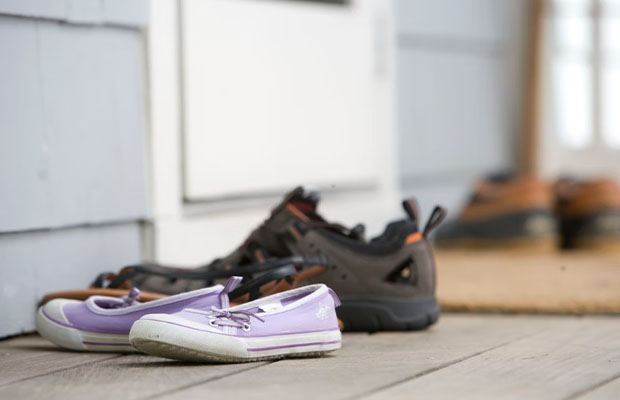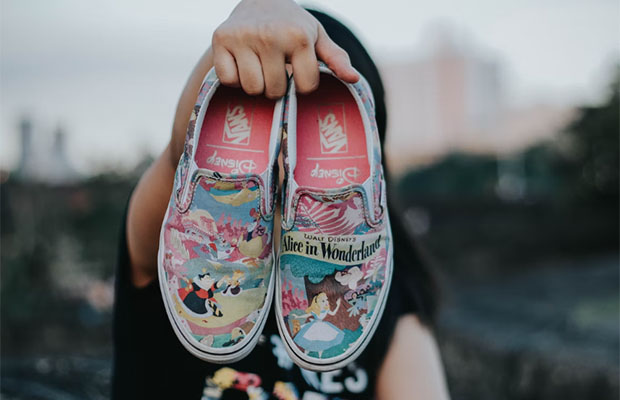Are Flat Shoes Bad For Your Feet? Facts To Know

We are all aware that the shoes we wear can have a significant impact on the health of our feet, but what exactly about flat shoes makes them bad for our feet and can they cause foot pain?
Are flat shoes bad for your feet? As with high heels, inadequate flat shoes alter your posture, which places damaging pressure on joints and tissues. To keep your balance and facilitate walking, you unconsciously adjust your movements, which causes back, hip, and knee issues.
Foot pain, structural damage to the foot and ankle, corns and calluses, as well as numerous other problems and pathologies further up the food chain, can all be long-term effects of your footwear.
In this article, we’ll talk about “flat shoes” and the effects they might have over time on your feet. Let’s start!
Table of Contents
What Is A Flat Shoe?
A flat shoe is a design that has a flat midfoot or innersole, which means the arch of the foot is not supported and the sole of the shoe does not conform to the shape of your arch. Shoes with no heel-to-toe drop (HTT drop) may also fall under this category. This might include thongs (flip flops), dress or ballet flats for women, or casual flats. While wearing flat shoes frequently may be acceptable in some circumstances, we advise against them because they can cause various foot, ankle, lower limb, and other pathologies.

What Health Issues Can Flat Shoe Cause?
They may experience a variety of health issues if they wear flat-soled shoes for an extended period of time. Many of us only consider the shoe’s size and not necessarily how the sole will affect us, even though we all know and understand that we need properly fitting shoes.
1. Plantar Fasciitis. Plantar fasciitis is a frequent ailment brought on by flat-soled footwear. This condition is distinguished by heel pain and stiffness along the bottom of your foot, where the plantar fascia ligament is located. The thin, long ligament that runs along the bottom of your foot, just beneath your skin, ends up bearing the majority of the shock when you wear flat-soled shoes because there is so little cushioning between your foot and the shock your foot must absorb. It suffers damage and inflammation as a result of this.
2. Skeletal misalignment Flat-soled shoes make your gait unsteady because they don’t give you a solid base to walk on. Your knees, pelvis, hips, and spine attempt to make up for this, which changes the alignment of your skeleton. Without changing your shoes and without stretching, your unnatural gait is likely to persist.
3. Blistering. Due to their lack of shock absorption, flat-soled shoes are more likely to cause blisters. Ballet shoes, slip-on sandals, and flip-flops are all made to be lightweight and thin, which forces your heels to absorb impact whenever you step down. Have you ever pondered the cause of blisters on the top of your foot, along the toes, or even at the base of your heel? This is why.
4. Ingrown Toenails. You may occasionally develop an ingrown toenail if you wear ballet flats on a regular basis. Your toes won’t have the space they need to spread out in the ballet shoe’s small toe box, and in some cases, they might even be forced together. Your toenails are more likely to grow inward, towards the skin, rather than outward, when this occurs. An infection may result from a toenail that is left untreated.
How To Prevent Flat Shoe Problems?
Here are some strategies you can use to avoid developing the aforementioned health issues, even though the simplest solution is to simply stop wearing flat-soled shoes.
- Choose flats with arch support if you have plantar fasciitis. Additionally, pick flats with a very thick sole so that you are absorbing less shock when you walk. If you’re really determined to wear your flats, you might also think about investing in some orthotic inserts. These can provide you with a little more support and assist in absorbing some shock.
- Find ballet flats or loafers with very high arch supports to correct misalignment. In order to give your feet the space they need to move without interfering with shifting, you might also want to look for an expensive pair with a toe box that is significantly wider.
- You need a shoe with a larger sole and a low heel to help prevent blistering. Remove the offending shoes from your rotation and switch to another pair until the blisters have healed.
- Shoes that allow your toes to move around inside the shoe box are necessary if you have ingrown toenails. The shoe is too narrow if you wiggle your toes and they hurt you when they rub against the side of the shoe or squish together. This holds true for ballet flats as well as any other closed-toe shoe.
Crucial Factors To Bear In Mind When Buying Shoes
What characteristics should we look for in our footwear now that we are aware that flat shoes can result in a number of problems? When choosing the style and brand of shoes that will work best for you and your feet, there are a number of features to take into account. These include;
Size: Be sure your shoes are fitted by a professional. The shoe’s width and length must be taken into account. Corns, blisters, nerve inflammation, and other forefoot pathologies can result from shoes with a narrow toe box. The foot’s structural changes, such as bunions or clawed/hammer toes, can be caused by wearing shoes that are too big or small over an extended period of time.
Foot type: Your podiatrist can determine your foot type and talk to you about how this may influence the shoes you choose. You might be neutral (not rolling in or out), pronated (rolling in), or supinated (rolling out).
Arch support: You might need a shoe with some arch support depending on your foot type or posture. Your plantar fascia, the muscle that creates your arch, will be overworked without arch support or contour, making it more vulnerable to plantar fasciitis, a condition that causes the muscle to degenerate.
Cushioning and shock absorption: Your shoes should give your feet a plush, cushioned surface. The overall impact on your joints will be reduced thanks to the shock absorption provided by your cushioned shoe. As opposed to shoes with a hard, thin sole, cushioned footwear typically feels more comfortable.
Ankle support: Flat shoes almost never offer ankle support. If you wear ballet flats or thongs, neither of which has anything encircling or supporting the ankles, you may be more susceptible to ankle sprains.
Added factors to think about
Will you wear them on a particular surface? Is it hard, soft, or perhaps uneven? The type of surface you will spend the majority of your time on should help you choose your shoes. In order to support the joints and the soft tissue structures and prevent them from suffering damage, a shoe worn on a hard surface should have plenty of cushioning and shock absorption.
How long will you be in them? To ensure you have access to all the features mentioned above while wearing these shoes all day every day, check their specifications. Less of these ideal features are acceptable if you only intend to wear your shoes occasionally.
What sort of work will you be doing there? Will you be moving around or remaining still for extended periods of time? Your shoe must allow for the type of movement you intend to make; for instance, if you plan to move side to side, your shoe must offer medial and lateral (inside and outside of the foot) support.
Your footwear is how flexible? Flexibility in shoes is typically not a good thing. A shoe that is flexible won’t give your foot’s structures enough support because your foot isn’t typically very flexible. Only in areas where the foot is flexible will a good shoe be flexible.
Using breathable materials, are your shoes constructed? In addition to considering how much air can reach our feet, we must also think about how durable our footwear is. Tinea pedis (also known as athlete’s foot) is a fungal infection of the skin that thrives in sweaty conditions.
How long have you owned your present pair of shoes? Your shoes’ wear patterns and the materials used for the upper can both be used to determine how worn they are. You should, as a general rule, replace your shoes every six to twelve months, or about 700 kilometers. Another smart move is to rotate several pairs of shoes; this will help your shoes last a little bit longer.
Utilizing Foot’s Natural Defense Mechanisms
How about the idea of going barefoot in the midst of all this talk about shoes? How on earth could this be beneficial for my feet? Even though we are aware that shoes were initially made to support and protect our feet, could this be making our feet more vulnerable to injury?
According to the barefoot philosophy, we should return to our natural state and let the foot function as it would in the absence of human intervention. According to the research, wearing shoes teaches the intrinsic foot muscles to shut off, making us more vulnerable to injury, while increasing barefoot activity encourages the strengthening of these muscles. Now, the problem is that going from high levels of support to bare feet will put us at a high risk of injury. What then is the remedy in this case? We advise alternating between wearing supportive footwear and going barefoot (at home). (There is only one circumstance where this is not true: if you have neuropathy in your feet, it is always advised that you wear shoes. Additionally, we advise discussing with your podiatrist how to strengthen the intrinsic muscles in your feet. If done consistently, this can lessen your risk of injury and foot-related problems.
Conclusion
We are aware that wearing flat shoes over time can increase a variety of risk factors and negatively impact our biomechanics.
If you really want to go with a shoe that has a flatter sole, we would recommend looking into either wedge heels or athletic sneakers. An athletic sneaker will give you much better arch support, whereas a wedge heel will give you better support and balance due to its slight angle to the sole. Additionally, by securing the heel, sneakers offer better heel support.
Choosing the right shoes is proving to be challenging, so make sure you schedule an appointment with one of our podiatrists right away. Bring your current shoes in for evaluation, please!
Other Posts You Might Like: Bump On Top Of Foot
Tags: Flat Shoes